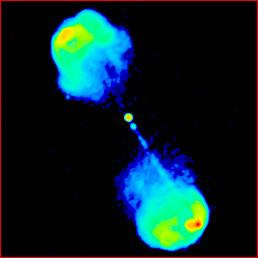 Image:
Image:3C 47 | B0133+207 |
| S178 | Alpha | FR | Class | ID | Spectrum | Best z | mag. | LAS | lg P178 | D |
|---|---|---|---|---|---|---|---|---|---|---|
| 28.8 | 0.98 | II | CD | QSO | 0.425 | V = 18.1 | 77.50 | 26.97 | 342.1 |

| Size: | 76.8 × 76.8 arcsec² |
|---|---|
| LUT: | Logarithmic |
| Beam: | 1.0 arcsec |
| Frequency: | 1650 MHz |
| Method: | CLEAN/VTESS’ėˇ>1.0
|
| Telescope: | VLA A+B |
| Credits: | Leahy (1996) |
The axis defined by the jet and hotspots is significantly rotated relative to that defined by the main lobes, giving the structure an S symmetry which suggests that the jet is precessing.
Because its high flux density makes observation easy, this is one of the best examples of the Laing-Garrington effect, which has been studied in detail in 3C 47 by Fernini et al. (1991); see also Leahy (1996).
Superluminal motion with a speed of about 6 c has been detected in the compact core (Vermeulen et al. 1993). This is interesting in the context of unified schemes since it is one of the most lobe-dominated quasars, which suggests that it is pointed about as far off our line of sight as it is possible for a quasar to be. The observed superluminal motion nevertheless implies that it is aligned within about 20° of the line of sight, which is consistent with the very strong Laing-Garrington effect. This is an example of the sort of evidence which has led to the idea that quasars pointing at right angles from us must be seen as something else, namely radio galaxies.
The faint compact peak on the south-east edge of the northern lobe has
a flat spectrum, and is probably a background quasar.
| Prev. | Data Page | Other images | Next | Search | Alphanumeric List | Icon List | Atlas Index |
|---|